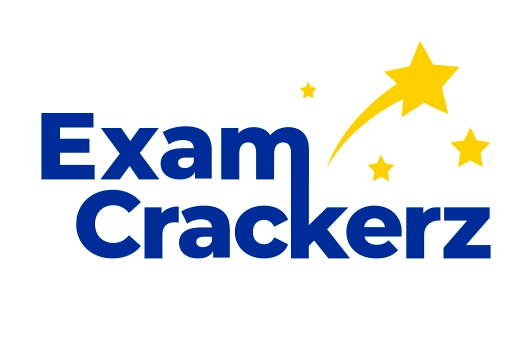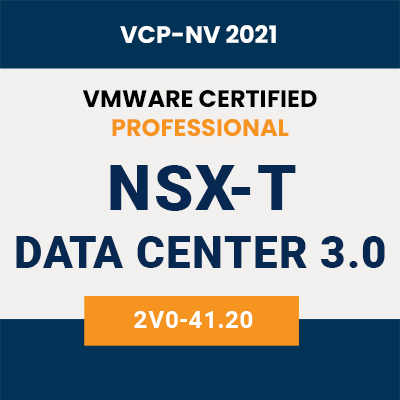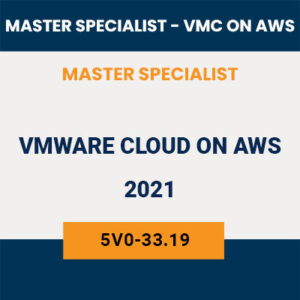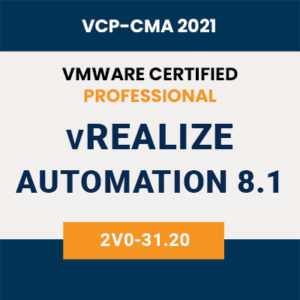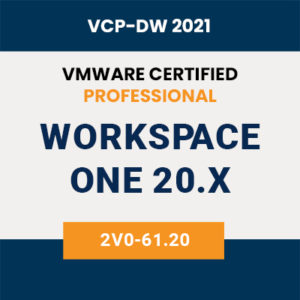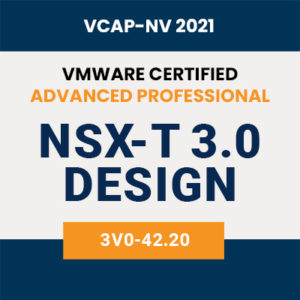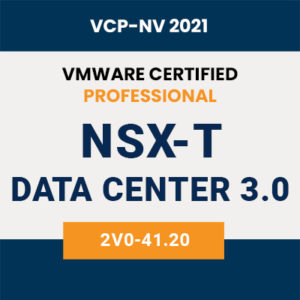Description
Exam Details
The Professional VMware NSX-T Data Center 3.0 exam (2V0-41.20) which leads to VMware Certified Professional –
Network Virtualization 2021 certification is a 70-item exam, with a passing score of 300 using a scaled method.
Candidates are given an appointment time of 130 minutes, which includes an adequate time to complete the exam for
non-native English speakers.
Exam Delivery
This is a proctored exam delivered at Pearson VUE testing centers, world-wide. For more information, visit the Pearson VUE website.
Certification Information
For details and a complete list of requirements and recommendations for certification attainment, please reference the VMware Education Services – Certification website.
Minimally Qualified Candidate
The minimally qualified candidate should have 6 months or more experience installing, configuring, managing, and
troubleshooting NSX-T Data Center 3.0 solutions. Candidates should be knowledgeable of the features, functions, and
architectures of NSX-T. They should have at least 6 months hands-on experience with Linux and KVM. They should have 1
year of experience working in IT and with VMware vSphere and its command line. The successful candidate will likely hold
additional industry-recognized IT certifications or accreditation. The MQC should have all the knowledge contained in the
exam sections listed below.
Exam Sections
VMware exam blueprint sections are now standardized to the seven sections below, some of which may NOT be included in the final exam blueprint depending on the exam objectives.
Section 1 – Architecture and Technologies
Section 2 – Products and Solutions
Section 3 – Planning and Designing
Section 4 – Installing, Configuring, and Setup
Section 5 – Performance-tuning, Optimization, and Upgrades
Section 6 – Troubleshooting and Repairing
Section 7 – Administrative and Operational Tasks
If a section is missing from the list below, please note it is because the exam has no testable objectives for that section. The objective numbering may be referenced in your score report at the
end of your testing event for further preparation should a retake of the exam be necessary.
Sections Included in the Exam
Section 1 – Architectures and Technologies – There are no testable objectives for this section
Section 2 – VMware Products and Solutions
Objective 2.1 Describe the VMware Virtual Cloud Network Vision
Objective 2.2 Outline the Solutions of NSX Portfolio
Objective 2.3 List the Use-cases for NSX-T Data Center
Objective 2.4 Explain the Value Proposition and Features of NSX
Objective 2.5 Identify Physical and Virtual Infrastructure Requirements for NSX-T Data Center
Objective 2.6 Describe NSX-T Data Center Architecture and Component Sub-systems
Objective 2.7 Differentiate the Functionalities of MP, CCP, DP and Consumption Planes
Objective 2.8 Define NSX-T Data Center Terminology
Objective 2.9 Describe the Logical Switching Architecture and Features
Objective 2.10 Describe the Logical Routing Architecture and Features
Objective 2.11 Describe the NSX-T Data Center Network Services
Objective 2.12 Explain the Edge Architecture and Features
Objective 2.13 Explain the NSX-T Data Center Security Architecture and Features
Objective 2.14 Identify the Supported Integration Platforms of NSX-T Data Center (Containers, Public Cloud, Private Cloud, Hybrid Cloud, DevOps tools, 3rd Party etc.)
Section 3 – Planning and Designing – There are no testable objectives for this section
Section 4 – Installing, Configuring, and Setup
Objective 4.1 Outline the installation and Preparation Workflow of NSX-T Data Center
Objective 4.2 Deploy and Configure NSX-T Data Center Environment
Objective 4.3 Configure Hypervisor Networking [vSphere and KVM] for NSX-T Data Center
Objective 4.4 Configure and Manage Logical Switching Features
Objective 4.5 Configure and Manage Logical Routing Features
Objective 4.6 Configure NSX-T Edge Nodes and Edge Cluster
Objective 4.7 Configure NSX-T Data Center Network Services [Layer-3]
Objective 4.8 Configure NSX-T Data Center Security Features
Objective 4.9 Configure Service Insertion with NSX-T Data Center
Section 5 – Performance-tuning, Optimization, Upgrades – There are no testable objectives for this section
Section 6 – Troubleshooting and Repairing
Objective 6.1 Identify the default Log File Locations of NSX-T Data Center Components
Objective 6.2 Compare and Contrast Tools Available for Troubleshooting
Objective 6.3 Troubleshoot Common NSX-T Data Center Installation/Configuration Issues
Objective 6.4 Troubleshoot Common NSX-T Data Center Component Issues
Objective 6.5 Troubleshoot Common Connectivity Issues
Objective 6.6 Troubleshoot Common Physical Infrastructure Issues
Section 7 – Administrative and Operational Tasks
Objective 7.1 List Operations Tasks in a VMware NSX-T Data Center Environment (syslog, backup/restore etc.)
Objective 7.2 Configure Roles and Permissions for NSX-T Data Center Environment
Objective 7.3 Generate Log Bundles
Objective 7.4 Monitor a VMware NSX-T Data Center Implementation
